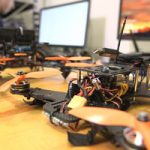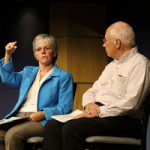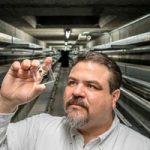MESA fabs get an upgrade
Sandia has completed phase one of an anticipated three-year upgrade at its plant responsible for making integrated circuits, similar to computer chips. The facility is now fully compatible with industry-standard, 8-inch silicon wafers — thin, round starting materials used for making chips.
Autonomy New Mexico interns build drones to test hypersonic tech
Sandia is developing autonomy and artificial intelligence for flight systems soaring at more than 3,800 mph. The technologies to get there will initially be tested on drones that shuffle around at about 5 mph.
Hate to wait? Hruby Fellow looks to speed up climate research
Sandia has awarded Kelsey DiPietro a Jill Hruby Fellowship. The applied mathematician has proposed a way to make computer models more efficient — improving accuracy without increasing time or resources to run them.
Containing a nuclear accident with ground-up materials
Sandia researchers are developing a promising new way to contain the hot molten mass that develops within a nuclear reactor during a catastrophic accident and prevent the spread of radioactive contamination.
Strategic Priority No. 5
Sandia's Strategic Priority No. 5 is seeking new pathfinder systems to address threats. The goal of this strategic priority is to think beyond Sandia’s traditional boundaries, taking advantage of the Labs' technical depth and breadth across multiple disciplines. Inventing and demonstrating these systems are important steps toward creating the future at Sandia.
Seeing infrared
Sandia researchers have developed tiny, gold antennas to help cameras and sensors that “see” heat deliver clearer pictures of thermal infrared radiation for everything from stars and galaxies to people, buildings and items requiring security.
Younger: A Sputnik moment is coming
Laboratories Director Steve Younger and Chief Research Officer Susan Seestrom took the stage at the Steve Schiff Auditorium Aug. 26 to discuss “discovery science” and what it means for Sandia. The talk was the latest installment of the New Research Ideas Forum.
Personalized medicine software vulnerability uncovered by Sandia researchers
Sandia researchers have identified a weakness in one common open-source software for genomic analysis that left DNA-based medical diagnostics vulnerable to cyberattacks. Their research helped software developers fix the problem before any significant attacks were identified.
Dragonflies: A lesson in missile defense
Dragonflies catch 95% of their prey, crowning them one of the top predators in the world. Now, Sandia researchers are discovering how dragonfly brains might be wired to be extremely efficient at calculating complex trajectories. Their discoveries could lead to improvements in missile defense systems.
Portable gas detection shrinks to new dimensions
A sensor for detecting toxic gases is now smaller, faster and more reliable, thanks to researchers at Sandia. The sensor’s performance sets it up for integration into a highly sensitive, portable system for detecting chemical weapons. The sensors can also rapidly detect airborne toxins.









